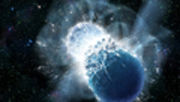Choose timezone
Your profile timezone:
 The meeting is centred on the most recent developments and findings in the strangeness physics, in particular the possible role of strangeness in neutron stars, on the discovery of gravitational waves and on the future of these fields, considering that a copious source of gravitational waves are expected to be the binaries of neutron stars. Combining the theoretical and experimental findings in these sectors will allow a better and more accurate understanding of the involved processes, at the crossroad between strong interaction and general relativity.
The meeting is centred on the most recent developments and findings in the strangeness physics, in particular the possible role of strangeness in neutron stars, on the discovery of gravitational waves and on the future of these fields, considering that a copious source of gravitational waves are expected to be the binaries of neutron stars. Combining the theoretical and experimental findings in these sectors will allow a better and more accurate understanding of the involved processes, at the crossroad between strong interaction and general relativity.